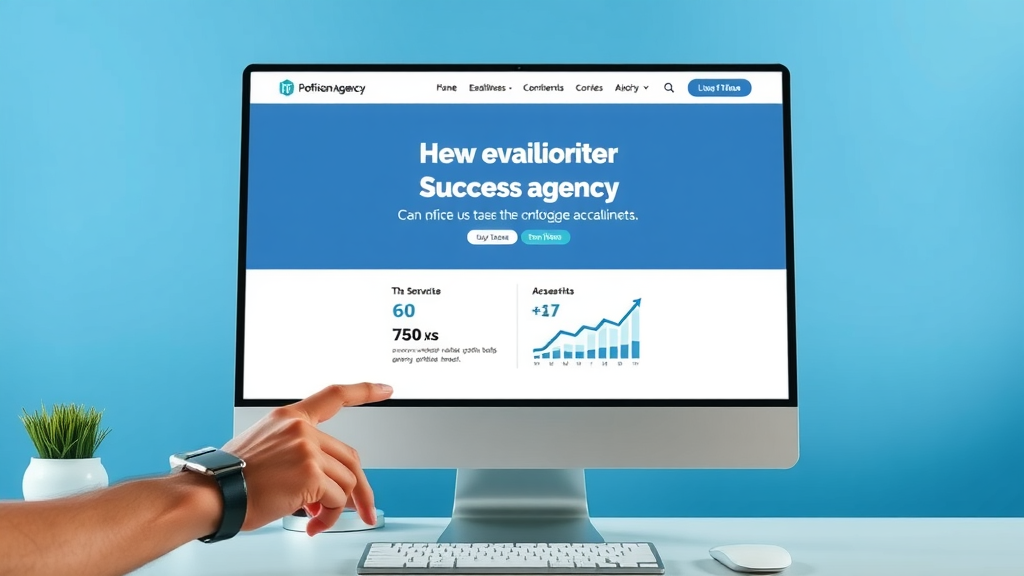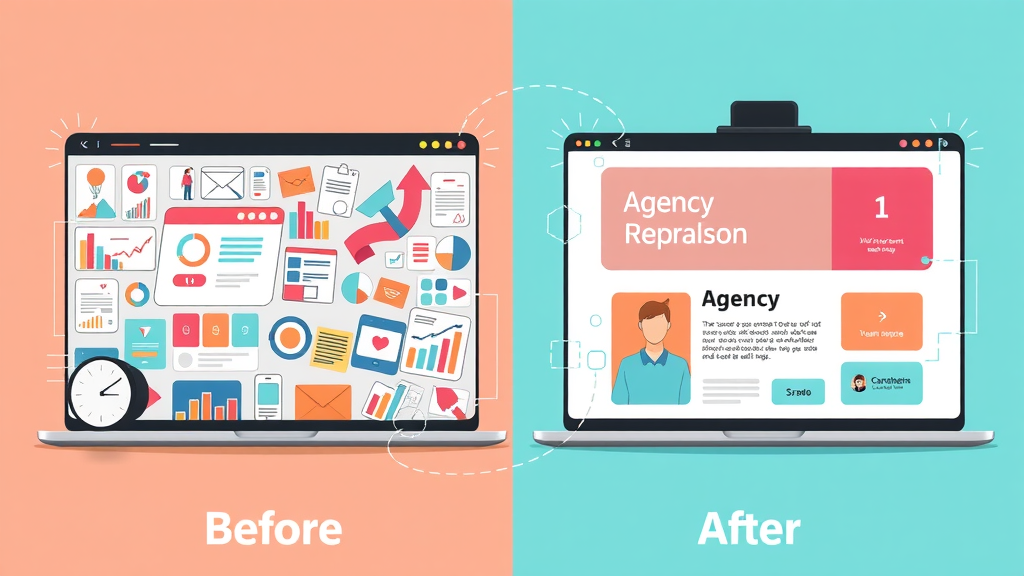Are you wondering why your agency website isn’t bringing in new leads or building the credibility you deserve? Most agency websites don’t work because they miss the mark on what matters: connecting with the audience, creating value, and optimizing for real business results. In this article, we’ll uncover the most common agency marketing mistakes, share proven strategies that transform websites into lead engines, and show you the step-by-step secrets to making your agency stand out in a crowded market. Read on to discover what the best agencies do— and what yours can change today.
Unlocking the Truth: Agency Marketing Mistakes Holding You Back
- Explore why so many agency websites fail to generate leads and how proper agency marketing can transform your results.
Agency marketing is at the heart of every successful digital marketing firm, yet the majority of agency websites struggle to deliver consistent inbound leads. Too often, these sites act as static brochures rather than engines for growth. The fundamental reason is typically a set of avoidable agency marketing mistakes : unclear messaging, weak calls-to-action, generic content, and lack of focus on the audience’s true needs. When agency marketing is misaligned with what potential clients actually seek—clarity, value, and trust—your website becomes an obstacle instead of an asset.
Consider the contrast: Agencies with effective agency marketing strategies treat their website as a dynamic extension of their brand. They combine targeted messaging, strategic content, and conversion-driven design to capture interest and nurture prospects. By addressing your audience’s pain points, demonstrating results, and guiding visitors along a clear path, your agency website can shift from being just another digital business card to a reliable, measurable tool for new client acquisition. Let’s break down these mistakes and how you can overcome them.

Understanding Agency Marketing: Core Principles for Success
- Discover the foundational agency marketing strategies that make a tangible difference, from brand positioning to lead generation.
At its core, agency marketing is about positioning your business to be the obvious solution for your clients’ biggest challenges. The foundation includes clarity of brand identity , deep understanding of target markets, and a unified digital presence. Every messaging touchpoint, from website copy to social media to email campaigns, should be aligned with your agency’s unique selling proposition and speak directly to your ideal client’s needs.
Effective agency marketing strategies also prioritize lead generation with a focus on value: downloadable resources, insightful case studies, and clear calls-to-action. This turns your website from a passive information hub into a proactive driver of qualified inquiries. The principle is simple—deliver trust and value before asking for a conversion. Building authority, demonstrating expertise, and showcasing meaningful outcomes foster the credibility that transforms visitors into opportunities.
Optimization is continuous. The best agencies don’t just launch a website and leave it; they measure client engagement, iterate their approach, and refine messaging based on what converts . This cycle of testing and improvement sets successful agency marketing apart, ensuring your website performs as a lead-generation machine, not just an online brochure.
| Effective Agency Marketing | Ineffective Agency Marketing |
|---|---|
|
|
Top Reasons Agency Websites Fail at Agency Marketing
Lack of Target Audience Clarity in Agency Marketing
One of the most significant failures in agency marketing is not understanding or clearly defining the ideal target audience. Without this essential clarity, agency websites end up with broad, unfocused messaging that tries to appeal to everyone—ultimately speaking to no one. When prospects visit your site and don’t see their unique pain points, goals, or industry language reflected immediately, they leave. Agency marketing succeeds when your brand and services are positioned specifically for defined client segments , from startups needing branding to enterprises seeking complex digital transformations.
Strategic audience targeting begins with in-depth research: analyzing buyer personas, mapping customer journeys, and uncovering what matters most to different market segments. Tailoring your website structure, navigation, and stories for these segments ensures that each visitor feels understood. Use specific visuals, industry examples, and language that speaks their vernacular. The most effective agency marketing delivers the right message, to the right person, at the right time – straight from the first homepage headline.
If your agency website’s copy could fit any generic digital agency, you’re not differentiating. Take time to audit your content: Is it filled with buzzwords and jargon, or does it get granular about whom you serve? Target audience clarity sets high-performing agency marketing apart , transforming general visitors into engaged, qualified leads from the very first click.
Poor Conversion Optimization and Agency Marketing
Another core issue holding agency websites back is poor conversion optimization . A beautiful site is wasted if it doesn’t drive visitors to action—whether that’s scheduling a call, downloading a case study, or joining your newsletter. Many agencies focus on aesthetics but ignore the science of converting interest to intent.
Conversion optimization in agency marketing starts with mapping out the priority actions you want prospects to take. Are your calls-to-action (CTAs) prominent, clear, and persuasive? Does your site minimize friction by giving visitors easy paths to contact you or request more info? Agencies that master agency marketing continually test layouts, headlines, color schemes, and CTA placements, measuring what actually drives results.

Neglecting these basics means missed opportunities. Effective agency marketing uses tools like heatmaps, analytics, and A/B testing to discover where users drop off and why. Even small tweaks—like simplifying forms or streamlining navigation—can mean the difference between a visitor and a new client. Without continual focus on conversion, even the most visually appealing agency websites won’t generate consistent results.
Insufficient Content that Demonstrates Agency Marketing Expertise
In the fiercely competitive agency landscape, it’s not enough to say you’re an expert—you need to prove it. Insufficient or generic content fails to position your agency as an authority . Potential clients are searching for reassuring evidence that you understand their challenges and can deliver measurable value. Yet, many agency websites rely on generic service descriptions or stock blog posts instead of meaningful, original content.
Compelling agency marketing content includes in-depth case studies, data-driven whitepapers, expert blog posts, and engaging videos that tackle real client pain points. Share before-and-after results, explain your strategies in plain English, and highlight unique frameworks or processes that set your agency apart. Showcase your team’s expertise and make it easy for prospects to visualize working with you.
Original, relevant, and actionable content—optimized with the keywords your audience is searching for—demonstrates not just expertise but authority. Agencies that invest in publishing thought leadership, success stories, and educational resources earn attention and build trust far faster than those relying on hollow filler content.
- 5 Common Agency Website Mistakes That Stifle Growth:
- Vague value proposition that doesn’t connect with ideal clients
- No clear call-to-action for lead generation
- Outdated design or poor mobile experience
- Lack of proof: no testimonials, reviews, or case studies
- Slow loading times and technical SEO issues
"Your website is your agency's digital storefront—if it isn't connecting with your audience, it's turning them away."
- Highlights the difference between just having a site and mastering agency marketing.

High-Impact Agency Marketing Strategies to Transform Your Site
Leveraging Content Marketing for Agency Websites
Content marketing is the heartbeat of effective agency marketing. It’s not just about filling your site with words—it’s about offering valuable resources that educate, inspire, and move prospects closer to action. Start by identifying the questions and pain points your target clients face. Then, create interconnected articles, guides, videos, and downloadable resources designed to answer those questions better than anyone else.
Utilize different content types to address visitors at each stage of their journey: beginner guides for newcomers, advanced insights for decision-makers, and practical tools like checklists and templates for those ready to act. Successful agency marketing content stands out by focusing on outcomes, not just services —show clients how you empower growth, solve problems, or unlock new opportunities. The more you give away for free (knowledge, tools, frameworks), the more you position your agency as the obvious choice.
SEO Essentials: Ranking Your Agency Marketing Offer
Even the best content is wasted if it’s not discoverable. SEO is an essential pillar of agency marketing —making sure your offers and insights appear in front of your exact audience right when they are searching for solutions. Focus on optimizing main keyword phrases like “agency marketing,” but don’t stop at the basics.
Perform ongoing keyword research to uncover the terms your competitors are ranking for. Optimize your page titles, headings, and meta descriptions; use keyword-rich, natural language in your website copy and blog posts. Ensure your site is technically sound: fast-loading, mobile-friendly, and logically structured. Quality backlinks from reputable industry sources and partnerships will further amplify your visibility and trust.
The most effective agency marketing strategies map keywords to critical client journeys, ensuring your agency is visible in every relevant search—whether someone is exploring general agency solutions or hunting for a specific service you offer. Show up, stand out, and earn clicks that convert .
Showcasing Results and Client Success Stories in Agency Marketing
Show, don’t just tell. Nothing beats real proof when it comes to convincing a potential client. Case studies, client testimonials, and data-backed results should be front and center in your agency marketing . These elements help prospects visualize tangible outcomes from working with you, setting the stage for more productive sales conversations.
Put a face and story to your successes with before-and-after visuals, detailed outcomes, and client quotes. Don’t just report metrics—explain what you did and how it made a difference. Make video testimonials or success story videos part of your strategy if possible. This powerful evidence provides extra assurance to skeptical prospects and turns your agency website from a list of promises into a gallery of proven results.
"Great agencies let results do their talking—make your wins visible and your value undeniable."
- Checklist: How to Optimize Your Agency Website for Leads
- Define your ideal client personas and target audience
- Craft a unique value proposition and communicate it clearly
- Feature compelling client reviews, testimonials, and case studies
- Streamline your site navigation and remove clutter
- Place clear, persuasive calls-to-action on every key page
- Optimize for mobile devices and fast loading speeds
- Publish educational, search-optimized content regularly
- Use chatbots or live chat for instant lead capture
- Implement analytics and user tracking for ongoing improvement

Real-World Agency Marketing: Case Studies of Agency Website Improvements
- Detailed examples of agency websites that fixed major agency marketing issues and experienced tangible results.
Seeing change in action is always more compelling than abstract advice. Consider an agency that struggled with a high bounce rate and stagnant leads for months. Their original website was filled with jargon, lacked a defined value proposition, and required visitors to hunt for contact details. After a website overhaul that focused on audience targeting, clear conversion paths, and detailed case studies, the agency saw a dramatic increase in engagement and qualified leads.
Another example featured a digital agency specializing in web design. Their site looked modern but didn’t convert visitors into consultations. By implementing clear CTAs, showcasing their best results on the homepage, and publishing a weekly blog focused on client stories, they more than doubled their inbound leads within six months. The proof? Tangible improvements in both traffic and conversions—measurable, trackable, and repeatable for any agency that adapts the same high-impact strategies.
| Metric | Before (Poor Agency Marketing) | After (Optimized Agency Marketing) |
|---|---|---|
| Bounce Rate | 73% | 49% |
| Average Session Duration | 0:58 mins | 2:34 mins |
| Monthly Qualified Leads | 8 | 25 |
| Conversion Rate | 0.6% | 3.0% |

Video: See Agency Marketing Tactics in Action
- A walkthrough or explainer video demonstrating critical agency marketing strategies applied to real-world agency websites.
Visual learners and agency owners benefit from seeing practical agency marketing strategies in action. In our recommended explainer videos, you’ll witness step-by-step walkthroughs of real agency website optimizations—covering before-and-after design, conversion path improvements, and SEO enhancements. These videos take the guesswork out of implementation, turning best practices into easy-to-understand blueprints for agency marketing success.
From streamlining landing pages to creating content hubs and integrating testimonials effectively, video tutorials break down the process so your team can confidently apply the same winning strategies. If you’re looking for actionable guidance and visual proof of what actually works, watching these case study–driven videos is a must.
Frequently Asked Questions about Agency Marketing
- What are the signs that my agency website needs a marketing overhaul?
If your website isn’t generating leads, has a high bounce rate, or receives visitor feedback that your offerings are unclear, it’s time to reconsider your agency marketing approach. Outdated design, poor mobile usability, and a lack of compelling success stories are other clear warning signs. A strong agency website consistently attracts, engages, and converts your ideal clients.
- How soon can I expect results after improving agency marketing tactics?
Results can start to appear within a few weeks of implementing agency marketing upgrades, such as new content, SEO enhancements, and improved calls to action. However, the most substantial change often happens within three to six months as search rankings climb and lead generation becomes more consistent. Commit to ongoing optimization for sustained success.
- What budget range is recommended for effective agency marketing on a website?
Budgets can vary widely based on your agency’s goals, competition, and starting point. For most agencies, a starting monthly investment of $2,000–$8,000 on agency marketing—including website updates, content creation, and targeted ads—delivers meaningful improvements. Remember, you can scale efforts as results appear, but under-investment usually means underwhelming outcomes.
- Should we prioritize branding or conversion in agency marketing first?
Both are crucial, but prioritize conversion-focused updates to generate leads and demonstrate value quickly. Strong branding should be built concurrently, ensuring your agency marketing communicates credibility and differentiation. Ideally, these efforts are integrated: a compelling brand presence that also drives action and results.

People Also Ask
- [[paa]]
- Answers with actionable insights addressing top user questions (expand as per actual PAA data).
When business owners research agency marketing, many also ask about specific tactics, timelines for seeing results, and whether to hire a specialist agency or manage marketing in-house. The best answers highlight practical steps: clarify your goals, audit your current results, and don’t hesitate to seek outside expertise if your website isn’t performing. Remember, effective agency marketing is a process, not a one-time fix .
Take the Next Step with Proven Agency Marketing Expertise
- Ready to grow your business? Book your free marketing strategy session with our team today. https://aaronmills.marketing/
Key Insights for Successful Agency Marketing
- Critical takeaways: focus on real value, strategic optimization, and client-centered content for agency marketing success.
Set clear goals, communicate unique value, and optimize for your audience—not just algorithms. Authentic case studies, a streamlined user experience, and SEO-driven content are the cornerstones of agency marketing that works. Stay proactive and always put your clients first.
To enhance your understanding of effective agency marketing strategies, consider exploring the following resources:
-
“Agency marketing: How to market your services and attract clients” : This article provides practical tips on developing a content portfolio that appeals to various audience personas and emphasizes the importance of content promotion over mere creation. ( webflow.com )
-
“Marketing agency: Definition, services offered, and benefits” : This resource outlines the common services provided by marketing agencies, such as comprehensive marketing planning, creative branding, digital marketing, content creation, and public relations, offering a clear understanding of how these services can benefit your agency. ( outsourceaccelerator.com )
By delving into these articles, you’ll gain actionable insights to refine your agency’s marketing approach and effectively attract and retain clients.
 Add Row
Add Row  Add
Add 



Write A Comment